How to use an air humidifier: the intricacies of operating and refilling climate control devices
Agree, if you don’t know how to use a humidifier correctly, you can quickly break it.To avoid damage to your device, we recommend that you first read its instructions and then read our article.
It provides basic recommendations for using a humidifier in an ordinary apartment or office.
The content of the article:
- Why are humidifiers needed?
- General rules for operating air humidifiers
- What kind of water can be used in a humidifier?
- How to add oil to a humidifier?
- How to clean a humidifier?
- The influence of open vents on the operation of the humidifier
- Typical problems when using a humidifier
- Conclusions and useful video on the topic
Why are humidifiers needed?
An air humidifier is a unique device. It is necessary to create an optimal indoor microclimate.
Other important functions of this device include:
- maintaining the required level of humidity in the room;
- elimination of static electricity charges (they can arise in dry air);
- cleaning the air from dust and microparticles of dirt, etc.
Air humidifiers prevent the development of various diseases of the upper and lower respiratory tract. They provide beneficial effect on skin, hair and nails, preventing the aging process. These devices can also be used to prevent nosebleeds in adults and children.
General rules for operating air humidifiers
Before connecting the humidifier to the network, you need to check the tightness of its housing and cord. If the housing is cracked or the cord is damaged, the product cannot be connected to the outlet. If the device fails, you need to contact a service center.
It (like any other equipment) is guaranteed. But the warranty will be void if you repair the humidifier yourself.
Features of activating the humidifier
To turn on humidifier, it must first be connected to the electrical network by inserting the plug into the socket. Then (depending on the type of device) you should press the on/off button on the unit body or activate the device using the remote control.
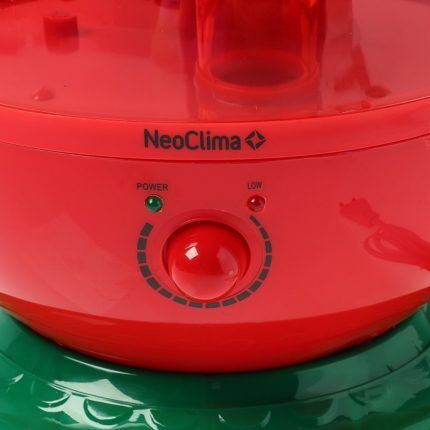
All additional functions of the humidifier are indicated on the display after switching on. To activate them, press the desired button on the LCD screen.
Features of using different types of humidifiers
The humidifier should be placed on a dry and level surface. The machine must be in a stable position, otherwise it may tip over during operation. Tilt of the device may interfere with its normal operation.
Before turning on a traditional type of humidifier, you need to place a filter in the water tray, attach the lower part of the device and secure the housing.
Then you need to fill the tank with distilled water and close the lid. After this, you should place the container on the lower part, turn on the device and select the most suitable mode using the switch on the body of the product.
If you need to turn on the steam humidifier, you should first fill it with water, keeping an eye on the liquid level indicator in the device.Then you need to turn on the device and select the operating mode.
During operation, the green indicator on the device body will light up. When all the water has evaporated from the tank, the indicator will turn red and the unit itself will automatically turn off.
Using ultrasonic humidifier a day before turning it on, you need to place the demineralization cartridge in a container with clean water. The next day, you need to fill the tank with water, close it with a lid and insert it into the housing. After this, you should install the part with the sprayer and turn on the unit.

If everything is done correctly, the green indicator on the device will light up. Then you need to select the appropriate mode and adjust the desired humidity level. When this parameter is reached, the humidifier will turn off on its own.
Safety precautions when working with a humidifier
Before turning on the humidifier, you should read its operating instructions. It provides general recommendations for using the device.
However, when using any type of humidifier, it is prohibited to:
- add liquid to the reservoir of the switched on device;
- use dirty water;
- rearrange the device plugged into the outlet;
- add flavoring agents directly to the water (there is a special compartment for this);
- pour water into the humidifier through the hole intended for the release of water vapor;
- block this hole, etc..
The operating time of the device depends on its design features. Steam humidifiers can achieve the desired level of humidification in just a couple of hours.But traditional models usually work slower and sometimes saturate the air with moisture for 10-12 hours.
Information on how long and at what mode the humidifier should operate in order to achieve the optimal level of humidity in the room can be found in the instructions.
Water is heavier than air, and moistened air currents automatically go down, and therefore it is better to install the device on a small elevation from the floor (for example, on a stool, coffee table, wall shelf or bedside table). Devices with large tanks (8-9 l) can be placed on a cabinet or high shelves.

A small humidifier should be at a minimum distance of 50 cm from the floor. If you place the device on the floor, a small puddle will soon appear around it.
Due to the nature of its operation, this device should not be placed next to:
- electrical appliances;
- walls (otherwise unsightly stains may appear on the wallpaper);
- upholstered furniture;
- books and clothes;
- central heating radiators (on the contrary, they dry out the air and can negate the benefits of using a humidifier).
The distance from these items to the humidifier should be about 30 cm so that moisture does not settle on them. Fine particles of water (after all, steam is one of the physical states of water) that get on technical devices can disrupt the operation of any equipment.
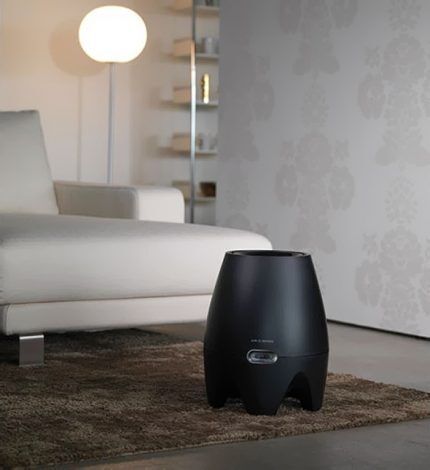
If there is an aquarium in the room, then you should not place a humidifier next to it.This is simply impractical, because water also evaporates from the aquarium, humidifying the air. Those. a double humidification effect is created, which can also negatively affect the indoor microclimate. Due to too much humidity in the apartment, pulmonary diseases worsen, and mold appears on the walls.
If there are children or pets in the house, the device should be placed out of their reach. In this case, it would be appropriate to install even a small air humidifier on a cabinet or high shelf.
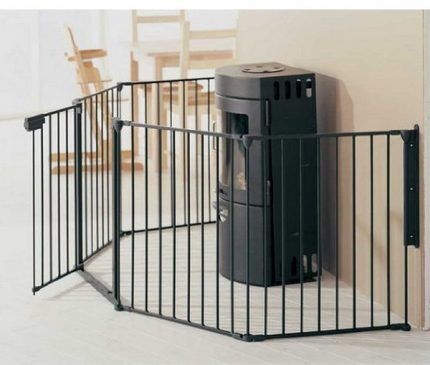
If there are no small children or pets in the apartment, then the humidifier can be placed in the middle of the room at some distance from the furniture. But the device should not interfere with free movement.
It is also important to remember that the humidifier is powered by electricity, so it must be installed near an outlet. If possible, you should avoid using surge protectors, extension cords and adapters, since these are additional connections and unnecessary contacts.
What kind of water can be used in a humidifier?
Not only the duration of operation of the device, but also the nature of the device’s effect on the human body depends on the quality of the water poured into the humidifier. If you use ordinary tap water in the unit, the salts and chlorides dissolved in it will enter the humidified air, and then end up in the respiratory tract of all people in the room.
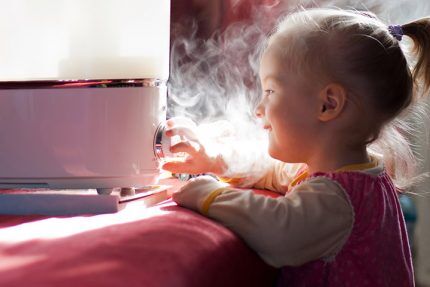
Also, using dirty tap water has a detrimental effect on the functioning of the device parts. Scale forms on them, and the elements quickly become unusable.
To prevent this from happening, you need to use only clean water (bottled, distilled, demineralized, spring or artesian).
In addition, you can pour boiled and filtered water into the device, but this is often not recommended.
Some chemical compounds (including salts) in tap water are not filtered and do not precipitate after boiling, and therefore can subsequently have a detrimental effect on the health of household members and on the operation of the humidifier itself.
Standing tap water will also not bring much effect. Typically, water is left to settle for 7-8 hours, assuming that in the first 2 hours, chlorine and hydrogen sulfide compounds evaporate from the liquid, and then heavy metal particles are removed from it. But in fact, it will still not be purified.
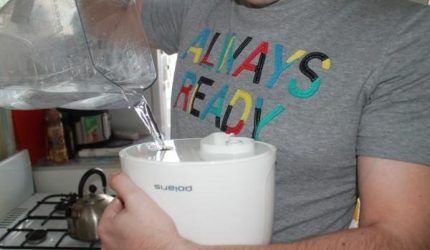
Today, many people are afraid to drink even filtered and boiled tap water, so why put it in humidifiers? It makes more sense to spend money on normal, clean water now than to look for money for medicine later.
Pure artesian water is even sold in vending machines on the streets, and it is inexpensive.Clean, moist air will automatically increase pulmonary immunity, and saving “on matches” (on elementary water!) will not lead to anything good.
If the humidifier does not use all the water from the reservoir in a day, it still needs to be changed and the container cleaned. The fact is that a warm and important environment is perfect for the growth of bacteria.

The humidifier should not stand with water. When servicing the humidifier and draining the water, it should be unplugged. Otherwise, you may get an electric shock.
How to add oil to a humidifier?
Not all humidifiers can add aromatherapy oils. Under no circumstances should oil be poured directly into the spray tank. The device must support the aromatherapy function and have a special compartment in which add essential oils and fill in specific compositions.
Such devices include:
- steam humidifiers;
- ultrasonic models;
- devices with a washing function.
Their design includes a special cassette or container. This is where the oil is poured, which is sprayed parallel to the water during operation of the humidifier. All aromatic oils poured into the spray unit must be of high quality and original.

In this case, the volume of essential oil used depends on the area of the room. Experts recommend using no more than 5 drops for every 15 sq.m. area.If these proportions are violated, all the benefits of aromatherapy disappear, headaches, allergic reactions and attacks of nausea may occur.
As for the duration of the procedure, a humidifier with essential oils should not work like a regular wash. When using for the first time, it is better to turn off the device after half an hour or an hour of aromatherapy and look at your condition.
If dizziness or increased blood pressure occurs, the duration of the session should be reduced.
How to clean a humidifier?
Any humidifier needs periodic cleaning. To descale the device, you need to take out a water container and disconnect all possible parts from the device. If there is any remaining water in the tank, it must be poured out and the tank must be thoroughly rinsed under the tap.
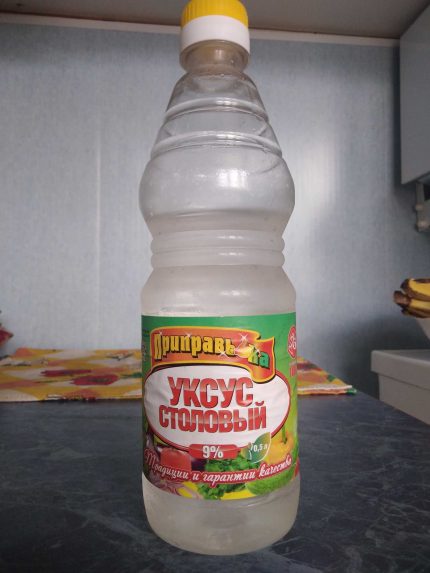
The humidifier membrane is cleaned with a special brush, which is sold complete with the device. If this brush is lost, it can be purchased separately at hardware stores.
As an alternative, a small sponge without metal threads or a fleece cloth is sometimes used. To maintain the tightness of the sealing material, you need to thoroughly dry the device between uses by removing the plug.
To clean the water tank, only soft cloths should be used. Brushes with a hard surface may cause scratches inside the tank. If too much scale has accumulated in the container, you need to take a toothbrush with soft bristles and regular table vinegar 9-15%.
To clean a humidifier with vinegar, you need:
- Open the balcony or window, as acetic acid vapors have a negative impact on health.
- Dilute half a glass of vinegar (100 ml) in 2.5 liters of clean water at room temperature.
- Pour the resulting mixture into the tank of the device.
- Plug the humidifier into the outlet and run it in fast mode for an hour (the spout of the device should be turned towards the window; it is better to leave the room during this time, closing the door tightly).
- Turn off the humidifier, disassemble and thoroughly rinse each part with water.
In addition to vinegar, you can use citric acid, soda, hydrogen peroxide and chlorine bleach to clean the device. Citric acid helps remove plaque safely.
Baking soda destroys putrid film and mold inside the device, which can appear due to high humidity. Hydrogen peroxide disinfects the humidifier reservoir. Bleach destroys pathogenic microflora in the tank and prevents its proliferation.
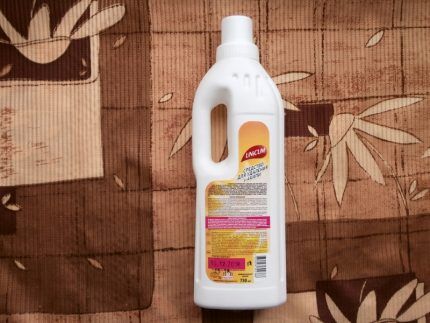
The filters in your humidifier need to be changed every few months. The exact replacement time depends on the type of device and the quality of the water used in the device.
These filters also need to be washed periodically under running water. You cannot use aggressive chemicals to clean them: its residues cannot be completely washed off with water.
The influence of open vents on the operation of the humidifier
Any humidifier is designed to work in a room of a certain area. If the device’s passport says that it is suitable for humidifying a room of 20 sq.m., then for a room of 40 sq.m. the unit will be useless.At the same time, the device can provide a normal microclimate only if all doors and windows in the room are closed.
If a window, door or window is open in the room, the efficiency of the humidifier will decrease. This will happen for two reasons. Firstly, due to open doors and windows, the area of the room will increase. Secondly, dry air will enter the room from the street or from other rooms and reduce humidity.
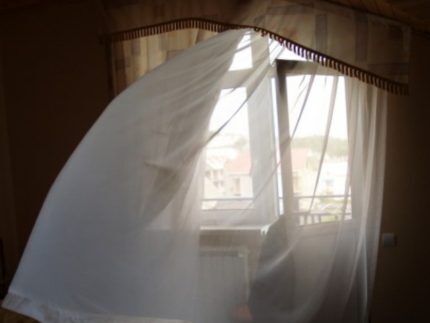
Moreover, air humidity directly depends on its temperature. Cold air contains less moisture than warm air. For example, at +20 the air contains 17.3 g/m3 water vapor, and at 0 degrees the maximum content is already 4.84 g/m3.
If you want to ventilate the room, then it is more rational to do this before turning on the device. But you shouldn’t leave the humidifier on all night with the window closed. Sleeping in a stuffy room, even with normal humidity, is unpleasant.
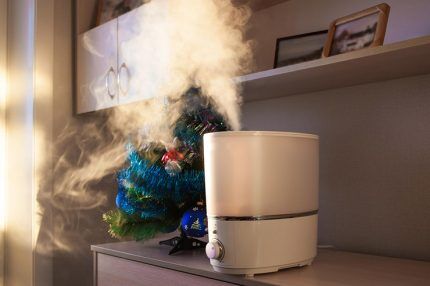
A humidifier should be used not only in winter, but also in summer. The air in the apartment may become too dry due to actively operating air conditioners and climatic (weather) factors. For humidification in summer, it is best to use models with cold steam and ultrasonic devices.
Typical problems when using a humidifier
Sometimes a number of problems arise when using air humidifiers. At the same time, you can deal with many device malfunctions yourself.
If the humidifier does not turn on, you need to check the presence of water in the tank and make sure that the device is actually connected to the mains. Often, users simply forget to plug in the humidifier and, as a result, cannot understand for a long time why it does not work.
If fine water dust does not come out of the steam outlet, then you need to thoroughly wash the device. These holes are often clogged with residual detergents. In addition to additional cleaning, you can use the regulator to set a higher humidity percentage.
Also, the absence of steam sometimes indicates that the liquid reservoir is overfilled and the supply channel is flooded. In this case, you need to drain some water and turn on the device again.
If this does not help, you need to check the condition of the membrane and the mechanism that drives it. If they are damaged, you will have to contact a service center.
If the spray is too weak, accompanied by noise, you need to check the amount of water in the container. This can happen if there is no longer liquid in the tank, but the device does not automatically turn off.
In ultrasonic models, such a malfunction may indicate contamination of the ultrasonic transducer. In this case, the converter must be removed, cleaned, dried and installed back into the humidifier.

If an unpleasant odor occurs from a working humidifier, you need to check the water and membrane. A similar smell may indicate that the water in the tank has stagnated and bloomed. Then you need to drain the liquid and wash the tank.If the membrane itself is dirty, you should thoroughly rinse the emitter with clean water and dry it well.
If the display on the device does not work (does not light up), then it is better to contact a service center specialist. Such malfunctions indicate a breakdown of the electronic component of the device.
Instructions for making a simple device for air humidification will familiarize you with next article, which we recommend reading to everyone interested in improving the microclimate of the surrounding space.
Conclusions and useful video on the topic
Proper use of a humidifier increases its effectiveness. When installing the device, you should read the instructions and find the most suitable place for the device in the room.
Also, before you start using the humidifier, you should watch the video instructions to avoid common mistakes:
The humidifier can be used both in the apartment and in the office. You can even let children near the device, just tell them the basic rules for using the device in advance.
Would you like to share your own experience in choosing, operating and maintaining a humidifier? Do you have useful information on the topic of the article that is worth sharing with site visitors? Please leave comments in the form below, ask questions, post photos.
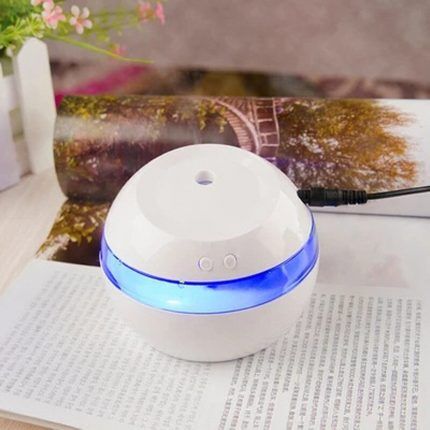




I'm sorry, what? Can I use spring water? And why is it better than tap water? 😀